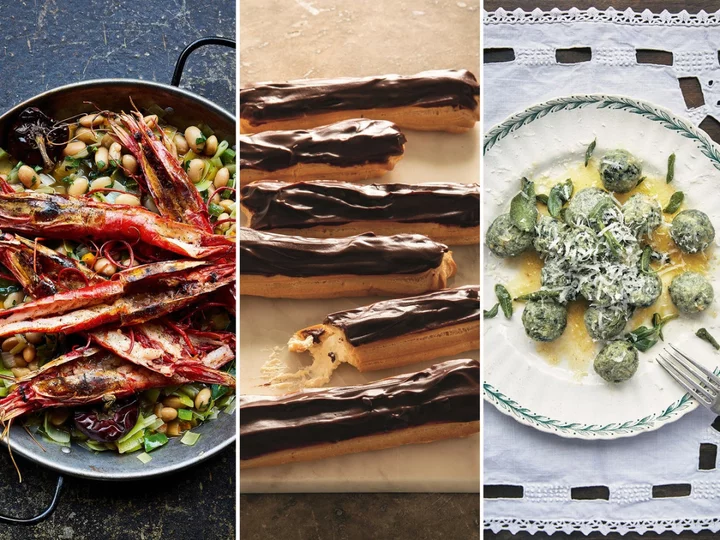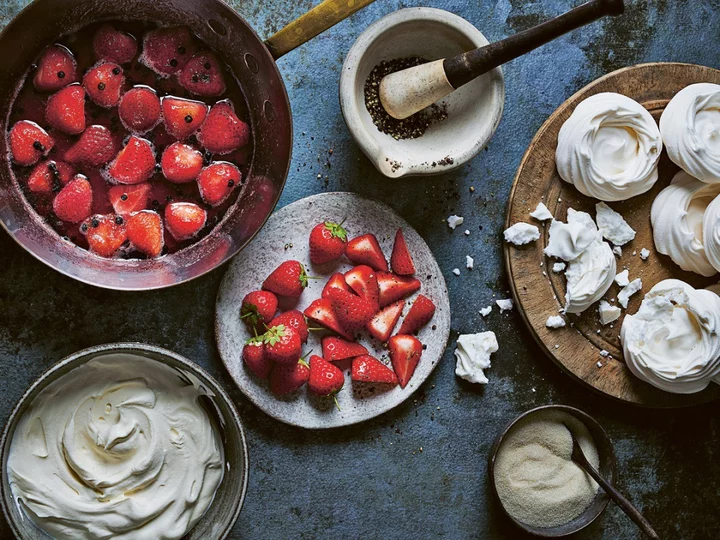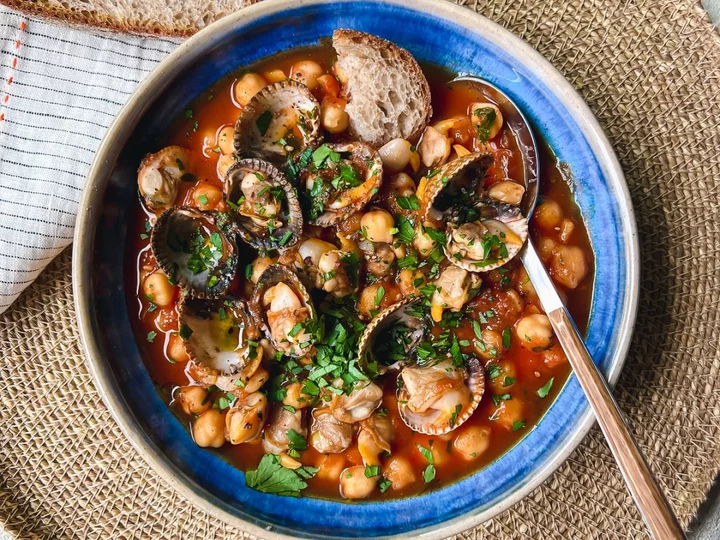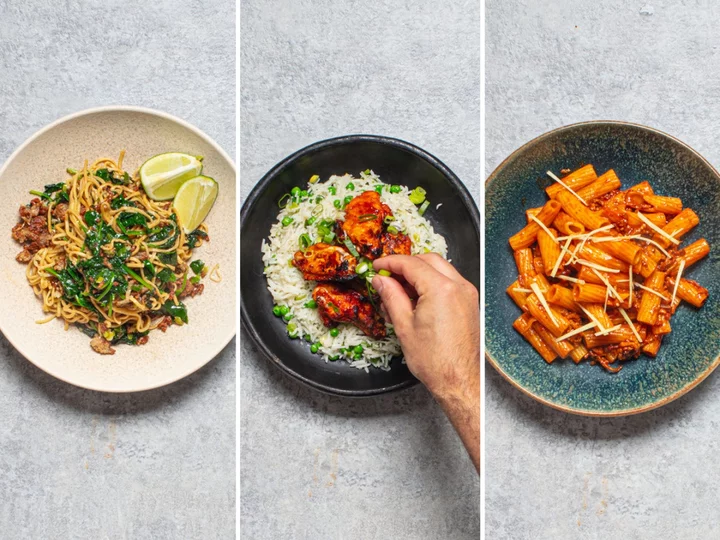This is the best time of year to discover new recipes.
As the days get shorter and colder, a glossy new cookbook – and all the food-related inspiration that comes with it – can be just the thing you need.
And there are plenty of new releases to sink your teeth into – whether you want to transport yourself to a sunnier country, settle down with some comfort food – or even get a head start on Christmas shopping.
Some of the biggest names in food – including chef and former Saturday Kitchen presenter James Martin, BBC stalwarts the Hairy Bikers, and cult restaurateur Russell Norman – have new cookbooks out – and this is what you can expect from each of them.
1. ‘James Martin’s Spanish Adventure’ by James Martin
If you were captivated by James Martin’s 20-part ITV series taking a culinary tour around Spain – from the Michelin-starred restaurants of San Sebastian to the local markets of Santiago de Compostela – you’ll want to pick up the accompanying cookbook.
One of Martin’s favourite areas in the country is Toledo, “a special ancient city right in the middle of Spain”, he notes. “It’s famous for great produce including game, saffron, honey, olive oil, garlic and the list goes on.”
Yorkshire-born Martin says he first fell in love with Spanish food when he came to London as a young chef, and wanted to dedicate this book to the cuisine because he “wanted people to know about the people, the fantastic variety of landscapes, and the spectacular produce available”, he says.
“They have the best markets in Europe and the range of ingredients is fabulous – the seafood, the meat, the vegetables and the fruit.”
In the cookbook, Martin highlights that Spanish cuisine is far more than just paella and sangria. There are plenty of recipes for traditional dishes – including tapas bites, croquetas, empanadas, Seville pork with patatas bravas and burnt Basque cheesecake – as well as classic Spanish ingredients (such as chorizo, olives and plenty of seafood).
While Spain is predominantly known for meat and fish, Martin also shows some of the beautiful ways the country uses vegetables too – such as a dish for deep-fried aubergines drizzled with honey and served with a tomato sauce, and salt-baked celeriac with new potatoes and salsa.
Valencia beans and red prawns
“Located on the east coast, the 2,000-year-old city of Valencia boasts wide sandy beaches, striking architecture, a buzzing food scene and culture,” says Martin.
“It has its own language (a dialect of Catalan) and unique cuisine, with a focus on rice, seafood and meat. This dish showcases red prawns on a bed of white beans and vegetables.”
Serves: 2
Ingredients:
75ml olive oil, plus extra for drizzling
2 garlic cloves, chopped
1 onion, diced
¼ leek, diced
½ carrot, peeled and diced
¼ green pepper, cored, deseeded and diced
3 bay leaves
2 whole smoked chilli peppers (or a pinch of chilli flakes)
300g cooked butter beans
Splash of white wine
Small bunch of flat-leaf parsley, chopped
8 red prawns, split lengthways
Sea salt
Method:
1. If you want to use a BBQ, heat a BBQ until hot and the coals are white.
2. Heat a medium paella pan and, when hot, add the oil, then add the garlic, all the vegetables, the bay leaves and the smoked peppers. Cook for two to three minutes, then stir in the beans, 50 millilitres of water and the wine and cook for three to four minutes. Season with salt and finish with the parsley.
3. Meanwhile, pop the prawns onto the BBQ, drizzle with oil and season with salt, then cook for two to three minutes until charred, turning once or twice. Alternatively, grill on high for three to four minutes.
4. To serve, remove the smoked peppers (if using) from the beans and then pile the prawns on top of the beans and drizzle with extra olive oil if desired.
‘James Martin’s Spanish Adventure’ by James Martin (Quadrille, £27)
2. ‘The Hairy Bikers’ Ultimate Comfort Food’ by Si King and Dave Myers
It’s hard to believe Dave Myers and Si King – otherwise known as the Hairy Bikers – have been on our screens for nearly two decades, with their first BBC show airing in 2004.
They’ve written plenty of cookbooks over the years – dedicated to everything from Mediterranean food to curries – and their latest is all about comfort food. In the introduction, the duo think back to what comfort food meant to them growing up – for Myers, it’s a classic chip butty, and King picks out his mother’s curries and casseroles.
British classics like these permeate the book – including beef and barley stew, sausage rolls and lemon drizzle cake – but there’s a definite international flavour, with dishes inspired by Myers and King’s travels all over the world. Think soba noodles with miso mushrooms, Szechuan lamb bao buns, chipotle prawn tacos and more.
While comfort food might make you think of heavy, rich dishes you want to curl up in the winter with – and those recipes are represented – there’s also a wider picture of ‘comfort’ and what it means throughout the year. Lighter recipes such as the teriyaki chicken salad and Spanish-style roasted vegetables with halloumi will bring just as much joy in the summertime.
Chocolate eclairs
“Possibly everyone’s top teatime pleasure, eclairs are a bit of work, but are so worth it,” say Myers and King.
“Just picture yourself biting into that beautiful choux pastry filled with cream and spread with chocolate.”
Makes: about 8-12
Ingredients:
For the choux pastry:
115g plain flour
100g butter
2 tsp caster sugar
1 tsp vanilla extract
Pinch of salt
3 eggs, well beaten
1 tbsp icing sugar
For the filling:
300ml double cream
1 tbsp icing sugar
½ tsp vanilla extract
For the chocolate glaze:
100g dark chocolate (or 50g dark chocolate and 50g milk chocolate)
50g whipping cream
50g butter
25g golden syrup
Method:
1. Preheat the oven to 180C/fan 160C/gas 4 and line two baking trays with baking parchment. Sift the flour on to another piece of baking parchment.
2. Put the butter, sugar, and vanilla extract in a pan with 225 millilitres of water and a generous pinch of salt. Heat gently until the butter has melted and the sugar has dissolved, then turn up the heat until the mixture is boiling. Remove the pan from the heat.
3. Pull up the sides of the baking parchment and slide the flour into the butter and sugar mixture. Stir the flour into the wet ingredients to form a thick paste which should come away from the sides of the pan in one solid mass. Put the pan back over a gentle heat and continue stirring with a wooden spoon for two or three minutes, until the mixture is slightly steaming and leaves a floury residue on the base of the pan.
4. Leave to cool for a couple of minutes, then beat for a couple of minutes more. You can then transfer the dough to a stand mixer or use electric beaters if you prefer. You will see steam escape from the dough at this point. Keep beating until the steam has subsided.
5. Gradually work in the eggs, just a couple of tablespoons at a time, until you have a thick glossy dough – it needs to be quite stiff and firm enough for you to draw your finger through it without the sides falling back in. The dough initially breaks up a lot, but eventually it will come together again.
6. Fit a large star or plain round nozzle into a piping bag and scoop the dough into the bag. If you don’t have a nozzle, simply snip off the end of the bag off – the hole should be about 2.5cm wide.
7. Pipe tiny amounts of the dough under the corners of the baking parchment on the trays to keep the parchment in place. For large eclairs, pipe eight lines of dough, as evenly as possible, on to the baking trays, making each one about 15cm long. To make sure they don’t spread to an oval shape, pipe them slightly wider at each end. To make slightly smaller eclairs, pipe 12 lines of about 10cm long. Wet your fingers and smooth out the ends of the eclairs if peaks have formed. If you haven’t used a star nozzle, run a fork along the length of each one.
8. Dust the eclairs with the icing sugar – this will help them darken and crisp up in the oven. Bake for 25 minutes by which time they should have formed a crust. Use a skewer to poke holes in each end of the eclairs so steam can escape from their centres, then continue to bake for another eight to 10 minutes. Turn the oven off and leave the door ajar. Leave the eclairs in the oven for about half an hour – this will help make sure they are crisp all the way through.
9. To make the filling, whip the cream until it is stiff, then fold in the icing sugar and vanilla extract. Chill for half an hour.
10. For the glaze, put the chocolate, cream, butter and golden syrup into a bowl over a saucepan of simmering water. Melt together gently to make a fairly thin ganache.
11. To fill the eclairs, cut three holes in the base of each one. Fill a piping bag with the cream and pipe it into the holes. Squeeze the eclairs lightly – they should feel nicely full. Dip each filled eclair in the chocolate glaze – this gives a much better coverage than trying to spread it – then leave them in the fridge to set. These are best eaten on the same day they are made as the pastry will eventually soften, but they will keep for up to 48 hours.
‘The Hairy Bikers: Ultimate Comfort Food’ by Si King and Dave Myers (Seven Dials, £25)
3. ‘Brutto’ by Russell Norman
Russell Norman’s debut cookbook, Polpo, won the Inaugural Waterstones Book of the Year back in 2012, and anything the London restaurateur has done since has always been hotly anticipated.
For his latest cookbook, Norman has turned his sights on Florence. Named after one of his London restaurants, “brutto” is the Italian word for ugly, and references the Italian expression, “brutto ma buono” – ugly but good.
Tuscan cuisine is known for meat, offal, game and beans, Norman explains in the introduction – and these are all represented in the cookbook, albeit with a few more veggie options than you might seen in a traditional Florentine kitchen.
You’ll learn a lot about food in Florence from Brutto – such as the city’s passion for wine bars, where antipasti such as coccoli (fried dough balls served with prosciutto and soft cheese) and deep-fried courgette flowers are served.
Some of the recipes are Italian classics you’ll know about – such as tagliatelle with ragu and asparagus risotto – and others are more unusual, deeper dives into Italian cuisine – think Florentine-style fried chicken or an oven-baked spinach dish cooked with eggs, cream, Parmesan and a dash of nutmeg.
Tuscan food is largely known as peasant food – meaning it’s relatively cheap and easy to make, while still being packed full of flavour.
Spinach and ricotta dumplings
“Gnudi translates as ‘naked’, as these little dumplings are the most nude and simple form of homemade pasta you can make,” says Norman.
“The combination of spinach and ricotta is a very traditional marriage and appears in much of the pasta of the region, in ravioli and crespelle for example. It’s a very satisfying process, and easy enough for children to help with in the kitchen if you want to encourage an early interest in Italian cooking for little chefs.”
Serves: 4
Ingredients:
500g baby spinach leaves, washed
50g ‘00’ flour
250g ricotta
1 large free-range egg, beaten
150g grated parmesan
Flaky sea salt
Black pepper
½ tsp freshly grated nutmeg
250g semolina
100g butter
A large handful of sage leaves
Method:
1. Steam the spinach for three minutes over a large pan of boiling water. Thoroughly drain and squeeze to remove the excess water, then chop the leaves finely. Set aside.
2. Mix the flour with the ricotta in a large bowl until it resembles lumpy breadcrumbs. Stir in the egg and two-thirds of the Parmesan. Add a pinch of salt, a twist of black pepper, the nutmeg and then add the spinach. Combine thoroughly with a wooden spoon or with your hands.
3. Put half the semolina into a bowl and shake the rest on to a baking sheet or a tray. Take small lumps of the flour, egg and spinach mixture and form them into small balls by rolling them between your palms, to the size of large olives. Turn each ball through the bowl of semolina, then place on the tray you’ve prepared with the rest of the semolina. When finished, you should have 24–30 little balls.
4. Fill a very large pan with water and bring to a rolling boil. Place the gnudi in the boiling water as quickly as possible, bringing it back to the boil on the highest heat, and continue to simmer for about three minutes.
5. Meanwhile, in a small saucepan over a medium heat, melt the butter and add the sage leaves. When it bubbles, reduce to a very low heat. This should take no more than two minutes, while the gnudi are cooking.
6. The gnudi will float to the surface when they are ready. Turn off the heat, remove them with a slotted spoon and drain the excess water on kitchen paper. Place on four warmed plates, pour the butter and sage over the top, then evenly distribute the remaining Parmesan. Add a flourish of black pepper.
‘Brutto’ by Russell Norman (Ebury Press, £32)
Read MoreFrom a £22 bag of pasta to £28 sandwich – why do they cost so much?
How to host a dinner party for under £2 per portion
Pearly Cow, Margate, restaurant review: Go for the steak, but stay for the potatoes
Three authentic Thai recipes to try at home
What does Saturday Kitchen’s Matt Tebbutt cook at home?
Three recipes that prove traditional Irish food is better than you think









